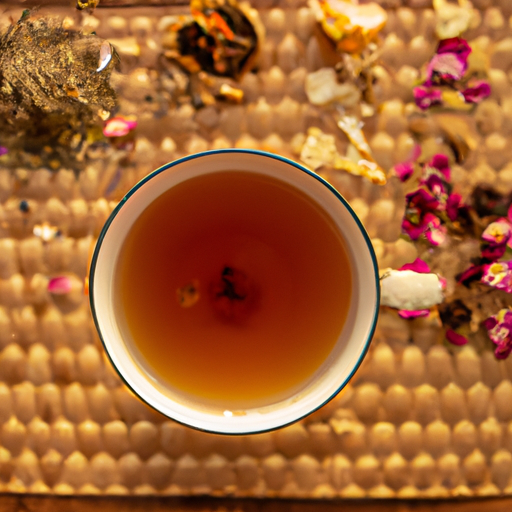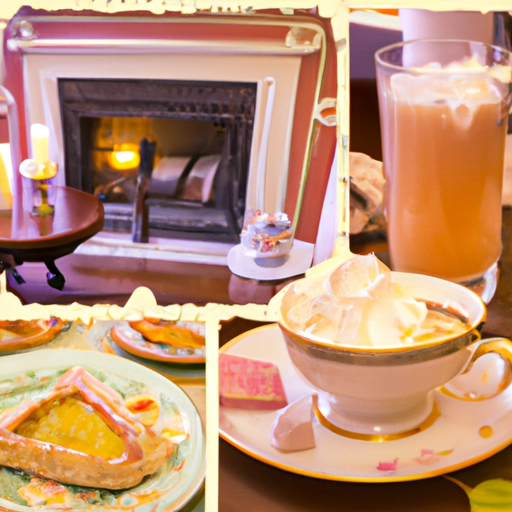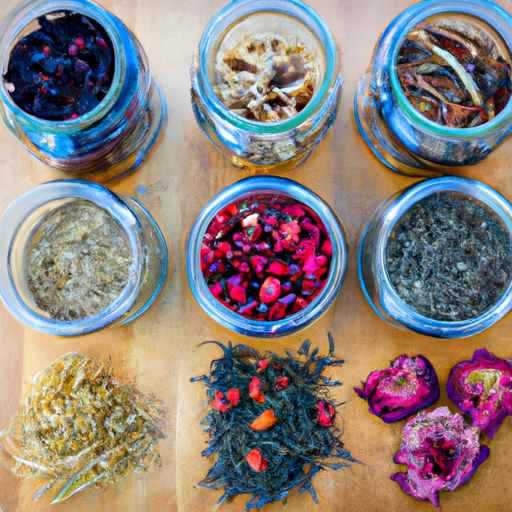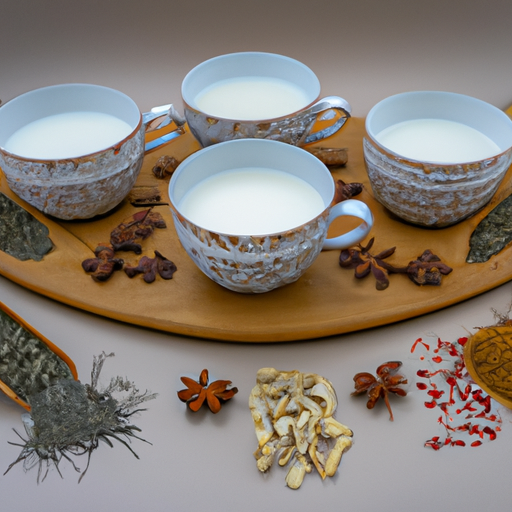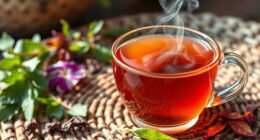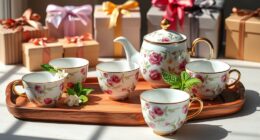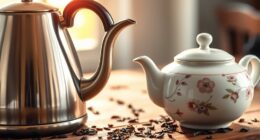Imagine a pounding headache, throbbing like a relentless drumbeat inside your skull. The pain consumes your thoughts, leaving you desperate for relief.
In these moments, turning to herbal tea can be a soothing and natural solution. With their healing properties and aromatic flavors, certain herbal teas have been found to effectively alleviate headaches.
Whether it’s the refreshing coolness of peppermint, the calming qualities of chamomile, or the invigorating warmth of ginger, each herbal tea offers its unique benefits.
Lavender tea, with its delicate floral notes, and lemon balm tea, with its citrusy zest, also hold promise in easing head pain.
For those seeking a herbal alternative to aspirin, willow bark tea may provide relief, while feverfew tea, known for its anti-inflammatory properties, could be another option.
So, the next time a headache strikes, consider reaching for a steaming cup of herbal tea to soothe your mind and ease your pain.
Key Takeaways
- Peppermint tea is a natural muscle relaxant and has anti-inflammatory properties, making it beneficial for headache relief.
- Chamomile tea has calming effects on the nervous system and can help reduce stress, which can contribute to headache relief.
- Lavender tea eases tension, promotes relaxation, reduces inflammation, and can help improve sleep, all of which can help alleviate headaches.
- Willow bark tea and feverfew tea are herbal alternatives to aspirin and can help reduce headache intensity and frequency, but it is important to consult a healthcare professional for appropriate dosage and to be aware of potential side effects.
Peppermint Tea
If you’re looking for a soothing remedy for your headache, sip on some refreshing peppermint tea and let the cool, invigorating flavor wash away your pain. Peppermint has long been used for its medicinal properties, and it’s known for its ability to relieve headaches. The menthol in peppermint acts as a natural muscle relaxant, helping to ease tension and alleviate pain.
Additionally, peppermint has anti-inflammatory properties that can help reduce the swelling and inflammation that often accompany headaches.
To make peppermint tea, simply steep 1 teaspoon of dried peppermint leaves in 1 cup of boiling water for about 5-10 minutes. You can adjust the steeping time to your preference for a stronger or milder flavor. Once the tea’s ready, strain out the leaves and enjoy the soothing aroma and taste of peppermint.
Peppermint tea isn’t only effective for headaches, but it also offers many other health benefits. It can aid in digestion, relieve nausea, and even help with symptoms of irritable bowel syndrome. So, next time you have a headache, reach for a cup of homemade peppermint tea and experience the natural relief it provides.
Now, let’s move on to another herbal tea that’s known for its calming properties – chamomile tea.
Chamomile Tea
Chamomile tea is a soothing herbal drink that has been used for centuries due to its calming effects on the nervous system and its ability to reduce stress. It contains compounds that work as natural sedatives, promoting relaxation and helping to alleviate symptoms of anxiety and tension.
Additionally, chamomile tea has been found to have analgesic properties that can ease headache symptoms, making it a popular choice for those seeking natural remedies.
Moreover, chamomile tea is well-known for its sleep-inducing properties, making it an excellent choice for those struggling with insomnia or seeking a peaceful night’s rest.
Calms Nervous System and Reduces Stress
Lavender tea eases tension and promotes relaxation, providing a soothing remedy for a headache. Its calming effects on the nervous system can help reduce stress, which is often a trigger for headaches. This natural remedy has been used for centuries to alleviate headaches and promote a sense of calm.
Here are a few reasons why lavender tea is beneficial for headache relief:
- Lavender contains compounds that’ve been shown to have a calming effect on the body, helping to reduce anxiety and stress.
- The aroma of lavender has been found to have a sedative effect, promoting relaxation and aiding in sleep.
- Studies have shown that lavender tea can help reduce inflammation, which can contribute to headache symptoms.
- Lavender tea is a natural alternative to over-the-counter pain medications, offering a gentle and soothing option for headache relief.
Transitioning into the next section, lavender tea not only eases headache symptoms but also promotes sleep, making it an excellent choice for those looking for a natural remedy.
Eases Headache Symptoms and Promotes Sleep
When you sip on a warm cup of lavender-infused brew, you’ll feel your headache melt away as a peaceful slumber envelops you like a soft cloud. Lavender tea is not only known for its calming properties, but it also eases headache symptoms and promotes sleep. The soothing aroma of lavender has been used for centuries to alleviate headaches and induce relaxation. Studies have shown that lavender tea can help reduce the severity and frequency of headaches by calming the nervous system and promoting better sleep quality. Additionally, lavender tea is a natural remedy for insomnia, making it a perfect choice for those who struggle with both headaches and sleep issues. So, if you’re looking for headache relief techniques and natural remedies for insomnia, try sipping on a cup of lavender tea before bed. Next, let’s explore the benefits of ginger tea.
Ginger Tea
To alleviate your headache, you should try sipping on a warm cup of ginger tea. Ginger tea is known for its numerous health benefits and has been used for centuries as a natural remedy for various ailments, including headaches.
This aromatic beverage is made by steeping fresh ginger root in hot water. Ginger tea is believed to have anti-inflammatory properties, which can help reduce the inflammation that often accompanies headaches. It also contains compounds called gingerols and shogaols, which have been shown to block pain signals in the brain, providing relief from headache symptoms. Additionally, ginger tea can help improve blood circulation, which can further alleviate headache pain.
To make ginger tea, simply peel and slice a small piece of fresh ginger root and steep it in hot water for about 10 minutes. You can add honey or lemon to enhance the flavor if desired. Sip on the warm tea slowly and let the soothing properties of ginger work their magic.
Now, let’s move on to another herbal tea that can help ease your headache: lavender tea.
Lavender Tea
One effective way to alleviate a headache is by incorporating lavender tea into my routine. Lavender tea is known for its soothing properties and can provide relief from headaches. Here are some benefits of lavender tea and a simple recipe to make it:
-
Lavender tea benefits:
- Calming effects: Lavender tea has a calming effect on the body and mind, which can help reduce stress and tension that often contribute to headaches.
- Anti-inflammatory properties: Lavender contains compounds with anti-inflammatory properties that may help reduce inflammation in the body, including the blood vessels in the head that can cause headaches.
- Relaxation and sleep aid: Drinking lavender tea before bed can promote relaxation and improve sleep quality, which can also help prevent headaches.
-
How to make lavender tea:
- Boil water in a pot or kettle.
- Place 1-2 teaspoons of dried lavender buds in a tea infuser or teapot.
- Pour the hot water over the lavender and let it steep for 5-10 minutes.
- Remove the infuser or strain the tea to remove the lavender buds.
- Enjoy your homemade lavender tea!
Now, let’s move on to the next section about lemon balm tea, another herbal remedy for headaches.
Lemon Balm Tea
After exploring the benefits of lavender tea for relieving headaches, let’s dive into another herbal remedy: lemon balm tea. As someone who’s experienced the discomfort of headaches, I understand the importance of finding natural remedies that actually work.
Lemon balm, also known as Melissa officinalis, has been used for centuries to treat various ailments, including headaches. One of the primary uses of lemon balm is its ability to reduce tension and promote relaxation. This herb contains compounds that have a calming effect on the nervous system, which can help alleviate the intensity of a headache. Additionally, lemon balm has been found to have mild analgesic properties, meaning it may provide some pain relief.
To prepare lemon balm tea, simply steep a handful of fresh lemon balm leaves or a teaspoon of dried leaves in hot water for about 5 minutes. You can also add a touch of honey or a squeeze of lemon juice to enhance the flavor.
If you’re looking for a delicious way to incorporate lemon balm into your diet, try adding it to salads, soups, or even making lemon balm-infused oils for cooking. The possibilities are endless!
Now, let’s move on to our next herbal remedy: willow bark tea.
Willow Bark Tea
Now, let’s delve into the soothing effects of willow bark tea, a natural remedy known for its ability to provide relief from discomfort. Willow bark, derived from the bark of the willow tree, has been used for centuries as a traditional medicine for various ailments, including headaches.
This herbal tea contains a compound called salicin, which is similar to the active ingredient found in aspirin. Salicin is believed to have anti-inflammatory and analgesic properties, making willow bark tea an effective option for alleviating headaches.
When it comes to the benefits of willow bark tea, research suggests that it may help reduce pain and inflammation associated with headaches. Some studies have found that consuming willow bark tea can lead to a significant decrease in headache intensity and duration. However, it’s important to note that the dosage of willow bark tea is crucial for its effectiveness. Experts recommend starting with a low dosage and gradually increasing it if necessary. It’s generally advised to consult with a healthcare professional to determine the appropriate dosage for individual needs.
Willow bark tea has been praised for its potential to relieve headaches due to its salicin content. As we transition to the next section, let’s explore the benefits of another herbal tea, feverfew tea, and its potential role in headache relief.
Feverfew Tea
After discussing the benefits of Willow Bark Tea, let’s now move on to another herbal tea that’s known to alleviate headaches: Feverfew Tea. I can personally attest to the effectiveness of this herbal remedy as someone who’s experienced migraines.
Feverfew, scientifically known as Tanacetum parthenium, has been used for centuries to treat various ailments, including headaches. This herb contains compounds called parthenolides, which have anti-inflammatory properties that can help reduce the intensity and frequency of headaches.
When it comes to dosage, it’s important to follow the recommended guidelines. Typically, one cup of Feverfew Tea is brewed using one teaspoon of dried Feverfew leaves steeped in boiling water for about 10 minutes. However, it’s always advisable to consult with a healthcare professional before starting any new herbal remedy, as individual responses may vary.
In addition to its headache-relieving properties, Feverfew Tea may also have other health benefits, such as reducing inflammation, managing arthritis pain, and relieving menstrual discomfort. However, more research is needed to fully understand its potential benefits and any potential side effects.
Overall, Feverfew Tea is a promising herbal remedy for those seeking a natural way to alleviate headaches. Remember to start with a small dosage and consult a healthcare professional for personalized advice.
Frequently Asked Questions
Are there any potential side effects or risks associated with drinking herbal tea for headaches?
Potential risks and side effects of drinking herbal tea for headaches are rare but can include allergic reactions or interactions with medications. Effective dosage recommendations vary, so consult a healthcare professional for guidance.
Can herbal teas be used as a long-term solution for chronic headaches, or are they only effective for occasional headaches?
Herbal teas can provide long-term efficacy for chronic headaches, especially when used as a complementary therapy with medication. Research suggests that certain herbal teas, like peppermint or chamomile, may help reduce headache frequency and intensity.
How should herbal teas be prepared and consumed to maximize their headache-relieving benefits?
Maximizing herbal tea’s headache relieving benefits can be achieved through proper preparation and consumption techniques. In addition, there are other natural ways to relieve headaches such as staying hydrated, managing stress, and getting enough sleep.
Are there any specific dosage recommendations for each type of herbal tea mentioned in the article?
Dosage recommendations for each type of herbal tea mentioned in the article vary depending on the specific herb. It is important to follow package instructions and consult a healthcare professional for individualized guidance on herbal tea effectiveness.
Are there any other natural remedies or lifestyle changes that can be combined with herbal tea to alleviate headaches more effectively?
Natural remedies such as applying a cold or warm compress to the forehead, practicing relaxation techniques like deep breathing or meditation, and making lifestyle changes like managing stress and getting enough sleep can complement the use of herbal tea in alleviating headaches.
Conclusion
In conclusion, herbal teas can be a natural and effective remedy for headaches. Peppermint tea, known for its soothing properties, can help relieve tension headaches.
Chamomile tea, with its calming effects, may be beneficial for migraines.
Ginger tea, with its anti-inflammatory properties, can help reduce headache pain.
Lavender tea, lemon balm tea, and willow bark tea have all been used traditionally to alleviate headaches.
While there may not be strong scientific evidence to support these claims, many individuals have reported positive results. For example, Sarah, a frequent headache sufferer, found relief by drinking chamomile tea daily.



